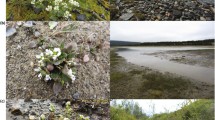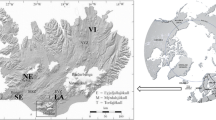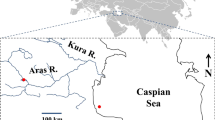Abstract
Halophila stipulacea is a dioecious marine angiosperm, widely distributed along the western coasts of the Indian Ocean and the Red Sea. This species is thought to be a Lessepsian immigrant that entered the Mediterranean Sea from the Red Sea after the opening of the Suez Canal (1869). Previous studies have revealed both high phenotypic and genetic variability in Halophila stipulacea populations from the western Mediterranean basin. In order to test the hypothesis of a Lessepsian introduction, we compare genetic polymorphism between putative native (Red Sea) and introduced (Mediterranean) populations through rDNA ITS region (ITS1-5.8S-ITS2) sequence analysis. A high degree of intraindividual variability of ITS sequences was found. Most of the intragenomic polymorphism was due to pseudogenic sequences, present in almost all individuals. Features of ITS functional sequences and pseudogenes are described. Possible causes for the lack of homogenization of ITS paralogues within individuals are discussed.



Similar content being viewed by others
References
N Arnheim (1983) Concerted evolution in multigene families. M Nei R Koehn (Eds) Evolution of genes and proteins. Sinauer Sunderland, MA
BG Baldwin MJ Sanderson JM Porter MF Wojciechowski CS Campbell MJ Donoghue (1995) ArticleTitleThe ITS region of nuclear ribosomal DNA: A valuable source of evidence on angiosperm phylogeny. Ann Ma Bot Garden 82 247–277
ES IV Buckler TP Holtsford (1996a) ArticleTitle Zea systematics: Ribosomal ITS evidence. Mol Biol Evol 13 612–622 Occurrence Handle1:CAS:528:DyaK28XhvFyisbc%3D
ES IV Buckler TP Holtsford (1996b) ArticleTitle Zea ribosomal repeat evolution and substitution patterns. Mol Biol Evol 13 623–632 Occurrence Handle1:CAS:528:DyaK28XitVOit70%3D
CS Campbell MF Wojciechowski BG Baldwin LA Alice MJ Donoghue (1997) ArticleTitlePersistent nuclear ribosomal DNA sequence polymorphism in the Amelanchier agamic complex (Rosaceae). Mol Biol Evol 14 81–90 Occurrence Handle1:CAS:528:DyaK2sXjvFOqsw%3D%3D Occurrence Handle9000756
JA Coyer GJ Smith RA Andersen (2001) ArticleTitleEvolution of Macrocystis spp. (Phaeophyceae) as determined by ITS1 and ITS2 sequences. J Phycol 37 574–585 Occurrence Handle10.1046/j.1529-8817.2001.037001574.x
J Denduangboripant QCB Cronk (2000) ArticleTitleHigh intra-individual variation in internal transcribed spacer sequences in Aeschynanthus (Gesneriaceae): Implications for phylogenetics. Proc R Soc Lond B 267 1407–1415 Occurrence Handle10.1098/rspb.2000.1157 Occurrence Handle1:CAS:528:DC%2BD3cXmsVSit78%3D Occurrence Handle10983824
V Di Martino G Marino MC Blundo (2000) ArticleTitleQualitative minimal area of a community with Halophila stipulacea from south-eastern Sicilian Coasts (Ionian Sea). Biol Mar Medit 7 677–679
GA Dover (1986) ArticleTitleMolecular drive in multigene families: How biological novelties arise, spread and are assimilated. Trends Genet 2 159–165 Occurrence Handle10.1016/0168-9525(86)90211-8 Occurrence Handle1:CAS:528:DyaL2sXltFWhsr8%3D
GA Dover (1989) ArticleTitleLinkage disequilibrium and molecular drive in the rDNA gene family. Genetics 122 249–252 Occurrence Handle1:CAS:528:DyaL1MXktlChsbo%3D Occurrence Handle2731732
JJ Doyle JL Doyle (1987) ArticleTitleA rapid DNA isolation procedure for small quantities of fresh leaf tissue. Phytochem Bull 19 11–15
P Famà JL Olsen WT Stam G Procaccini (2000) ArticleTitleHigh levels of intra- and inter-individual polymorphism in Caulerpa racemosa (Forssk.). J. Agardh. Eur J Phycol 35 349–356 Occurrence Handle10.1017/S0967026200002948
C Fritsch (1895) ArticleTitleÜber die auffindung einer marinen Hydrocharidee im Mittelmeer. Verh Zool Bot Ges Wien 45 104–106
A Gandolfi P Bonilauri V Rossi P Menozzi (2001) ArticleTitleIntraindividual and intraspecies variability of ITS1 sequences in the ancient asexual Darwinula stevensoni (Crustacea: Ostracoda). Heredity 87 449–455 Occurrence Handle10.1046/j.1365-2540.2001.00927.x Occurrence Handle1:CAS:528:DC%2BD38XivVyitQ%3D%3D Occurrence Handle11737293
M Gardiner-Garden JA Sved M Frommer (1992) ArticleTitleMethylation sites in angiosperm genes. J Mol Evol 34 219–230 Occurrence Handle1:CAS:528:DyaK38XhvVyqsLg%3D
T Gojobori Li Wen-Hsiung D Graur (1982) ArticleTitlePatterns of nucleotide substitution in pseudogenes and functional genes. J Mol Evol 18 360–369 Occurrence Handle1:CAS:528:DyaL38Xlt1Wgtrs%3D Occurrence Handle7120431
TA Hall (1999) ArticleTitleBioEdit: a user-friendly biological sequence alignment editor and analysis program for Windows 95/98/NT. Nucleic Acids Symp Ser 4 95–98
DJ Harris KA Crandall (2000) ArticleTitleIntra-genomic variation within ITS1 and ITS2 of freshwater crayfishes (Decapoda: Cambaridae): Implications for phylogenetic and Microsatellite studies. Mol Biol Evol 17 284–291 Occurrence Handle1:CAS:528:DC%2BD3cXosFynsA%3D%3D Occurrence Handle10677851
S Hartmann JD Nason D Bhattacharya (2001) ArticleTitleExtensive ribosomal DNA genie variation in the columnar cactus Lophocereus. J Mol Evol 53 124–134 Occurrence Handle1:CAS:528:DC%2BD3MXmt1Sjsbk%3D Occurrence Handle11479683
DM Hillis MT Dixon (1991) ArticleTitleRibosomal DNA: Molecular evolution and phylogenetic inference. Q Rev Biol 66 411–453 Occurrence Handle1:STN:280:By2C2M%2FmsFc%3D Occurrence Handle1784710
CE Hughes CD Bailey SA Harris (2002) ArticleTitleDivergent and reticulate species relationships in Leucaena (Fabaceae) inferred from multiple data sources: Insights into polyploid origins and nr DNA polymorphism. Am J Bot 89 1057–1073 Occurrence Handle1:CAS:528:DC%2BD3sXislejtA%3D%3D
EN Jellen RL Phillips HW Hines (1994) ArticleTitleChromosomal localization and polymorphism of ribosomal DNA in oat (Avena spp. Genome 37 23–32 Occurrence Handle1:CAS:528:DyaK2MXhtVGitQ%3D%3D
S Jinks-Robertson TD Petes (1993) ArticleTitleExperimental determination of rates of concerted evolution. Methods Enzymol 224 631–646 Occurrence Handle1:CAS:528:DyaK2cXis1agtbs%3D Occurrence Handle8264416
Y Kita M Ito (2000) ArticleTitleNuclear ribosomal ITS sequences and phylogeny in East Asian Aconitum subgenus Aconitum (Ranunculaceae), with special reference to extensive polymorphism in individual plants. Plant Syst Evol 225 1–13 Occurrence Handle1:CAS:528:DC%2BD3MXhsFGjsrk%3D
S Kumar (1996) PHYLTEST; Phylogenetic hypothesis testing, version 2.0. Pennsylvania State University University Park
S Kumar K Tamura IB Jakobsen M Nei (2001) MEGA2: Molecular Evolutionary Genetics Analysis software, Arizona State University Tempe
W-H Li C-I Wu C-C Luo (1984) ArticleTitleNonrandomness of point mutation as reflected in nucleotide substitutions in pseudogenes and its evolutionary implications. J Mol Evol 21 58–71 Occurrence Handle1:CAS:528:DyaL2MXntlGhuw%3D%3D Occurrence Handle6442359
Y Lipkin (1975) ArticleTitle Halophila Stipulacea, A review of a successful immigration. AQ.BOT 1 203–215 Occurrence Handle10.1016/0304-3770(75)90023-6
LM Márquez DJ Miller JB Mackenzie MJM Van Oppen (2003) ArticleTitlePseudogenes contribute to extreme diversity of nuclear ribosomal DNA in the hard coral Acropora. Mol Biol Evol 20 1077–1086 Occurrence Handle10.1093/molbev/msg122 Occurrence Handle12777522
G Muir CC Fleming C Schlötterer (2001) ArticleTitleThree divergent rDNA clusters predate the species divergence in Quercus petraea (Matt.) Liebl. and Quercus robur L. Mol Biol Evol 18 112–119 Occurrence Handle1:CAS:528:DC%2BD3MXotVOmsg%3D%3D Occurrence Handle11158370
M Nei (1987) Molecular evolutionary genetics. Columbia University Press New York
JM Pérès (1967) ArticleTitleThe Mediterranean benthos. Oceanogr Mar Biol Annu Rev 5 449–553
G Procaccini RS Alberte L Mazzella (1996) ArticleTitleGenetic structure of the seagrass Posidonia oceanica in the Western Mediterranean: Ecological implications. Mar Ecol Prog Series 140 153–160
G Procaccini S Acunto P Famà F Maltagliati (1999) ArticleTitleMorphological and genetic variability of Mediterranean populations of Halophila stipulacea (Forssk.) Aschers. (Hydrocharitaceae) at different spatial scale. Mar Biol 135 181–189 Occurrence Handle10.1007/s002270050615
KM Reed JD Hackett RB Phillips (2000) ArticleTitleComparative analysis of intra-individual and inter-species DNA sequence variation in salmonid ribosomal DNA cistrons. Gene 249 115–125 Occurrence Handle10.1016/S0378-1119(00)00156-6 Occurrence Handle1:CAS:528:DC%2BD3cXjsVeltLo%3D Occurrence Handle10831845
J Rozas R Rozas (1999) ArticleTitleDnasp version 3: An integrated program for molecular population genetics and molecular evolution analysis. Bioinformatics 15 174–175 Occurrence Handle10.1093/bioinformatics/15.2.174 Occurrence Handle1:CAS:528:DyaK1MXisVOksrY%3D Occurrence Handle10089204
MJ Sanderson JJ Doyle (1992) ArticleTitleReconstruction of organismal and gene phylogenies from data on multigene families: Concerted evolution, homoplasy and confidence. Syst Biol 41 4–17
S Schneider D Roessli L Excoffier (2000) Arlequin ver. 2.000: A software for population genetics data analysis. Genetics and Biometry Laboratory, University of Geneva Geneva, Switzerland
EA Serrão LA Alice SH Brawley (1999) ArticleTitleEvolution of the Fucaceae (Phaeophyceae) inferred from nrDNA-ITS. J Phycol 35 382–394 Occurrence Handle10.1046/j.1529-8817.1999.3520382.x
GP Smith (1976) ArticleTitleEvolution of repeated DNA sequences by unequal crossover. Science 191 528–535 Occurrence Handle1:CAS:528:DyaE28Xhs1Srurg%3D Occurrence Handle1251186
YB Suh LB Thien HE Reeve EA Zimmer (1993) ArticleTitleMolecular evolution and phylogenetic implications of internal transcribed spacer sequences of ribosomal DNA in Winteraceae. Am J Bot 80 1042–1055 Occurrence Handle1:CAS:528:DyaK2cXivFCgsbk%3D
N Takezaki A Rzhetsky M Nei (1995) ArticleTitlePhylogenetic test of the molecular clock and linearized trees. Mol Biol Evol 12 823–833 Occurrence Handle1:CAS:528:DyaK2MXns1yqsbg%3D Occurrence Handle7476128
RW van Nues J Venema JMJ Rientjes A Dirks-Mulder HA Raué (1995) ArticleTitleProcessing of eukaryotic pre-rRNA: The role of the transcribed spacers. Biochem Cell Biol 73 789–801 Occurrence Handle1:CAS:528:DyaK28Xit1Klu7c%3D Occurrence Handle8721995
R Villari (1988) ArticleTitleSegnalazioni floristiche italiane: 565. Halophila stipulacea (Forssk.) Aschers. (Hydrocharitaceae). Genere e specie nuovi per l’Italia. Inform Bot Ital 20 672
A Wagner N Blackstone P Cartwright M Dick B Misof P Snow GP Wagner J Barrels M Murtha J Pendleton (1994) ArticleTitleSurveys of gene families using polymerase chain reaction: PCR selection and PCR drift. Syst Biol 43 250–261
TJ White T Bruns S Lee J Taylor (1990) Amplification and direct sequencing of fungal ribosomal RNA genes for phylogenetics. MA Innis DH Gelfand JJ Sninsky TJ White (Eds) PCR protocols: A guide to methods and applications. Academic Press New York 315–322
M Zucker (1989) ArticleTitleOn finding all suboptimal foldings of an RNA molecule. Science 244 48–52 Occurrence Handle1:CAS:528:DyaL1MXkt1SnsbY%3D Occurrence Handle2468181
Acknowledgements
Sampling in the Red Sea was conducted by Ferruccio Maltagliati. We thank Wiebe Kooistra for critical review of the manuscript.
Author information
Authors and Affiliations
Corresponding author
Rights and permissions
About this article
Cite this article
Valeria Ruggiero, M., Procaccini, G. The rDNA ITS Region in the Lessepsian Marine Angiosperm Halophila stipulacea (Forssk.) Aschers. (Hydrocharitaceae): Intragenomic Variability and Putative Pseudogenic Sequences . J Mol Evol 58, 115–121 (2004). https://doi.org/10.1007/s00239-003-2536-0
Received:
Accepted:
Issue Date:
DOI: https://doi.org/10.1007/s00239-003-2536-0




